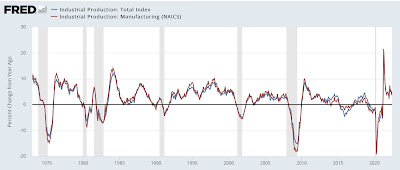June industrial production: second sharp monthly decline in manufacturing – by New Deal democrat Industrial production declined -0.2% in June, and May was revised downward to unchanged. Even worse, manufacturing production declined -0.5% in June, and May was revised downward to -0.5% as well: This corresponds to the sharp deterioration in the regional Fed new orders indexes, and the ISM manufacturing new orders index we have seen during that same time. On a YoY basis, total production is up 4.2%, while manufacturing is up 3.6%. Compared with the last 40 years, and particularly the last 20, this remains pretty good growth: The sharp deceleration in the past two months is not good, and two recessions – 1990 and 2007 – have started from
Topics:
NewDealdemocrat considers the following as important: New Deal Democrat, US EConomics
This could be interesting, too:
NewDealdemocrat writes JOLTS revisions from Yesterday’s Report
Bill Haskell writes The North American Automobile Industry Waits for Trump and the Gov. to Act
Bill Haskell writes Families Struggle Paying for Child Care While Working
Joel Eissenberg writes Time for Senate Dems to stand up against Trump/Musk
June industrial production: second sharp monthly decline in manufacturing
– by New Deal democrat
Industrial production declined -0.2% in June, and May was revised downward to unchanged. Even worse, manufacturing production declined -0.5% in June, and May was revised downward to -0.5% as well:

This corresponds to the sharp deterioration in the regional Fed new orders indexes, and the ISM manufacturing new orders index we have seen during that same time.
On a YoY basis, total production is up 4.2%, while manufacturing is up 3.6%. Compared with the last 40 years, and particularly the last 20, this remains pretty good growth:

The sharp deceleration in the past two months is not good, and two recessions – 1990 and 2007 – have started from these levels, but it has usually taken an even sharper downturn to coincide with the onset of a recession.
